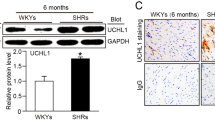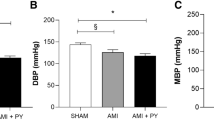Abstract
The acetylcholinesterase inhibitor donepezil restores autonomic balance, reduces inflammation, and improves long-term survival in rats with chronic heart failure (CHF) following myocardial infarction (MI). As arterial hypertension is associated with a significant risk of cardiovascular death, we investigated the effectiveness of donepezil in treating CHF in spontaneously hypertensive rats (SHR). CHF was induced in SHR by inducing permanent MI. After 2 weeks, the surviving SHR were randomly assigned to sham-operated (SO), untreated (UT), or oral donepezil-treated (DT, 5 mg/kg/day) groups, and various vitals and parameters were monitored. After 7 weeks of treatment, heart rate and arterial hypertension reduced significantly in DT rats than in UT rats. Donepezil treatment improved 50-day survival (41% to 80%, P = 0.004); suppressed progression of cardiac hypertrophy, cardiac dysfunction (cardiac index: 133 ± 5 vs. 112 ± 5 ml/min/kg, P < 0.05; left ventricular end-diastolic pressure: 12 ± 3 vs. 22 ± 2 mmHg, P < 0.05; left ventricular +dp/dtmax: 5348 ± 338 vs. 4267 ± 114 mmHg/s, P < 0.05), systemic inflammation, and coronary artery remodeling (wall thickness: 26.3 ± 1.4 vs. 34.7 ± 0.7 μm, P < 0.01; media-to-lumen ratio: 3.70 ± 0.73 vs. 8.59 ± 0.84, P < 0.001); increased capillary density; and decreased plasma catecholamine, B-type natriuretic peptide, arginine vasopressin, and angiotensin II levels. Donepezil treatment attenuated cardiac and coronary artery remodeling, mitigated cardiac dysfunction, and significantly improved the prognosis of SHR with CHF.

This is a preview of subscription content, access via your institution
Access options
Subscribe to this journal
Receive 12 print issues and online access
$259.00 per year
only $21.58 per issue
Buy this article
- Purchase on Springer Link
- Instant access to full article PDF
Prices may be subject to local taxes which are calculated during checkout





Similar content being viewed by others
Data availability
The datasets used and/or analyzed in the current study are available from the corresponding author upon reasonable request.
References
Yancy CW, Jessup M, Bozkurt B, Butler J, Casey DE, Jr Colvin MM, et al. 2017 ACC/AHA/HFSA Focused Update of the 2013 ACCF/AHA Guideline for the Management of Heart Failure: A report of the American college of cardiology/american heart association task force on clinical practice guidelines and the heart failure society of America. J Card Fail. 2017. https://doi.org/10.1016/j.cardfail.2017.04.014.
Ponikowski P, Voors AA, Anker SD, Bueno H, Cleland JG, Coats AJ, et al. 2016 ESC Guidelines for the diagnosis and treatment of acute and chronic heart failure: The Task Force for the diagnosis and treatment of acute and chronic heart failure of the European Society of Cardiology (ESC). Developed with the special contribution of the Heart Failure Association (HFA) of the ESC. Eur J Heart Fail. 2016;18:891–975.
Oparil S, Schmieder RE. New approaches in the treatment of hypertension. Circ Res. 2015;116:1074–95.
Androne AS, Hryniewicz K, Goldsmith R, Arwady A, Katz SD. Acetylcholinesterase inhibition with pyridostigmine improves heart rate recovery after maximal exercise in patients with chronic heart failure. Heart. 2003;89:854–8.
La Rovere MT, Bigger JT Jr, Marcus FI, Mortara A, Schwartz PJ. Baroreflex sensitivity and heart-rate variability in prediction of total cardiac mortality after myocardial infarction. ATRAMI (Autonomic Tone and Reflexes After Myocardial Infarction) Investigators. Lancet. 1998;351:478–84.
Packer M. The neurohormonal hypothesis: a theory to explain the mechanism of disease progression in heart failure. J Am Coll Cardiol. 1992;20:248–54.
Rosenwinkel ET, Bloomfield DM, Arwady MA, Goldsmith RL. Exercise and autonomic function in health and cardiovascular disease. Cardiol Clin. 2001;19:369–87.
Binkley PF, Nunziata E, Haas GJ, Nelson SD, Cody RJ. Parasympathetic withdrawal is an integral component of autonomic imbalance in congestive heart failure: demonstration in human subjects and verification in a paced canine model of ventricular failure. J Am Coll Cardiol. 1991;18:464–72.
McDonagh TA, Metra M, Adamo M, Gardner RS, Baumbach A, Bohm M, et al. 2021 ESC Guidelines for the diagnosis and treatment of acute and chronic heart failure. Eur Heart J. 2021;42:3599–726.
Kleiger RE, Miller JP, Bigger JT Jr, Moss AJ. Decreased heart rate variability and its association with increased mortality after acute myocardial infarction. Am J Cardiol. 1987;59:256–62.
Odemuyiwa O, Malik M, Farrell T, Bashir Y, Poloniecki J, Camm J. Comparison of the predictive characteristics of heart rate variability index and left ventricular ejection fraction for all-cause mortality, arrhythmic events and sudden death after acute myocardial infarction. Am J Cardiol. 1991;68:434–9.
Li M, Zheng C, Sato T, Kawada T, Sugimachi M, Sunagawa K. Vagal nerve stimulation markedly improves long-term survival after chronic heart failure in rats. Circulation. 2004;109:120–4.
De Ferrari GM, Crijns HJ, Borggrefe M, Milasinovic G, Smid J, Zabel M, et al. Chronic vagus nerve stimulation: a new and promising therapeutic approach for chronic heart failure. Eur Heart J. 2011;32:847–55.
Premchand RK, Sharma K, Mittal S, Monteiro R, Dixit S, Libbus I, et al. Autonomic regulation therapy via left or right cervical vagus nerve stimulation in patients with chronic heart failure: results of the ANTHEM-HF trial. J Card Fail. 2014;20:808–16.
Gold MR, Van Veldhuisen DJ, Hauptman PJ, Borggrefe M, Kubo SH, Lieberman RA. et al. Vagus nerve stimulation for the treatment of heart failure: the INOVATE-HF trial. J Am Coll Cardiol. 2016;68:149–58.
Li M, Zheng C, Kawada T, Inagaki M, Uemura K, Shishido T, et al. Donepezil markedly improves long-term survival in rats with chronic heart failure after extensive myocardial infarction. Circ J. 2013;77:2519–25.
Li M, Zheng C, Kawada T, Inagaki M, Uemura K, Sugimachi M. Adding the acetylcholinesterase inhibitor, donepezil, to losartan treatment markedly improves long-term survival in rats with chronic heart failure. Eur J Heart Fail. 2014;16:1056–65.
Li M, Zheng C, Kawada T, Inagaki M, Uemura K, Sugimachi M. Intracerebroventricular infusion of donepezil prevents cardiac remodeling and improves the prognosis of chronic heart failure rats. J Physiol Sci. 2020;70:11.
Li M, Zheng C, Kawada T, Inagaki M, Uemura K, Akiyama T, et al. Impact of peripheral α7-nicotinic acetylcholine receptors on cardioprotective effects of donepezil in chronic heart failure rats. Cardiovasc Drugs Ther. 2021;35:877–88.
Shimokawa H, Miura M, Nochioka K, Sakata Y. Heart failure as a general pandemic in Asia. Eur J Heart Fail. 2015;17:884–92.
Humphrey JD. Mechanisms of vascular remodeling in hypertension. Am J Hypertens. 2021;34:432–41.
Itter G, Jung W, Juretschke P, Schoelkens BA, Linz W. A model of chronic heart failure in spontaneous hypertensive rats (SHR). Lab Anim. 2004;38:138–48.
Brown IAM, Diederich L, Good ME, DeLalio LJ, Murphy SA, Cortese-Krott MM, et al. Vascular smooth muscle remodeling in conductive and resistance arteries in hypertension. Arterioscler Thromb Vasc Biol. 2018;38:1969–85.
Avitan I, Halperin Y, Saha T, Bloch N, Atrahimovich D, Polis B, et al. Towards a consensus on Alzheimer’s disease comorbidity? J Clin Med. 2021;10:4360.
Nordstrom P, Religa D, Wimo A, Winblad B, Eriksdotter M. The use of cholinesterase inhibitors and the risk of myocardial infarction and death: a nationwide cohort study in subjects with Alzheimer’s disease. Eur Heart J. 2013;34:2585–91.
Hsieh MJ, Chen DY, Lee CH, Wu CL, Chen YJ, Huang YT, et al. Association between cholinesterase inhibitors and new-onset heart failure in patients with Alzheimer’s disease: a nationwide propensity score matching study. Front Cardiovasc Med. 2022;9:831730.
Morris R, Luboff H, Jose RP, Eckhoff K, Bu K, Pham M, et al. Bradycardia due to donepezil in adults: systematic analysis of FDA adverse event reporting system. J Alzheimers Dis. 2021;81:297–307.
Baumgartner H, Falk V, Bax JJ, De Bonis M, Hamm C, Holm PJ, et al. 2017 ESC/EACTS Guidelines for the management of valvular heart disease. Eur Heart J. 2017;38:2739–91.
Li M, Zheng C, Kawada T, Uemura K, Inagaki M, Saku K, et al. Early donepezil monotherapy or combination with metoprolol significantly prevents subsequent chronic heart failure in rats with reperfused myocardial infarction. J Physiol Sci. 2022;72:12.
Silke B. Beta-blockade in CHF: pathophysiological considerations. Eur Heart J. 2006;8:C13–8.
da Silva Goncalves Bos D, Van Der Bruggen CEE, Kurakula K, Sun XQ, Casali KR, Casali AG, et al. Contribution of impaired parasympathetic activity to right ventricular dysfunction and pulmonary vascular remodeling in pulmonary arterial hypertension. Circulation. 2018;137:910–24.
DeFelice A, Frering R, Horan P. Time course of hemodynamic changes in ras with healed severe myocardial infarction. Am J Physiol. 1989;257:H289–96.
Collister JP, Hartnett C, Mayerhofer T, Nahey D, Stauthammer C, Krüger M, et al. Overexpression of copper/zinc superoxide dismutase in the median preoptic nucleus improves cardiac function after myocardial infarction in the rat. Clin Exp Pharm Physiol. 2016;43:960–6.
Miao Y, Li M, Wang C, Li H, Chen H. Effect of β-adrenergic receptor kinase inhibitor on post-myocardial infarction heart failure in rats. Int J Clin Exp Pathol. 2017;10:9858–65.
Fletcher PJ, Pfeffer JM, Pfeffer MA. Altered sensitivity to increases in vascular resistance in rats with hypertension and myocardial infarction. Am Heart J. 1986;111:120.
Cupples WA, Braam B. Assessment of renal autoregulation. Am J Physiol Ren Physiol. 2007;292:F1105–23.
Andersson U, Tracey KJ. Neural reflexes in inflammation and immunity. J Exp Med. 2012;209:1057–68.
Wang H, Yu M, Ochani M, Amella CA, Tanovic M, Susarla S, et al. Nicotinic acetylcholine receptor alpha7 subunit is an essential regulator of inflammation. Nature. 2003;421:384–8.
Hashimoto T, Ichiki T, Watanabe A, Hurt-Camejo E, Michaelsson E, Ikeda J, et al. Stimulation of alpha7 nicotinic acetylcholine receptor by AR-R17779 suppresses atherosclerosis and aortic aneurysm formation in apolipoprotein E-deficient mice. Vasc Pharm. 2014;61:49–55.
Funding
This study was partly supported by JSPS KAKENHI (grant numbers 26461099, 26430103, 20K20622, 22K08222), the research program of the Japan Agency for Medical Research and Development (22ama121050j0001), the Research Program of the Ministry of Internal Affairs and Communications (SCOPE: JP225006004), the Intramural Research Fund for Cardiovascular Diseases of the National Cerebral and Cardiovascular Center (21-2-7, 21-2-9), a research grant from JST (JPMJPF2018), and the research grant from NTT Research, Inc. The authors confirm that the funders did not influence the study design, contents of the article, or selection of this journal.
Author information
Authors and Affiliations
Contributions
Meihua Li and Can Zheng designed and performed the experiments. Meihua Li performed the statistical analyses and drafted the first manuscript. Toru Kawada, Kazunori Uemura, Shohei Yokota, Hiroki Matsushita, and Keita Saku interpreted the results. Toru Kawada and Keita Saku edited and reviewed the manuscript. All authors commented on the previous versions of the manuscript and read and approved the final manuscript.
Corresponding author
Ethics declarations
Ethics approval and consent to participate
Animal care protocols and all experiments were performed in strict accordance with the Guiding Principles for the Care and Use of Animals in the Field of Physiological Science, which was approved by the Physiological Society of Japan. All protocols were reviewed and approved by the Animal Subject Committee of the National Cerebral and Cardiovascular Center (#15004 and #16002).
Conflict of interest
The authors declare no competing interests.
Research involving human participants and/or animals
This study did not involve human participants. The Animal Subject Committee of the National Cerebral and Cardiovascular Center has approved the animal experiments.
Additional information
Publisher’s note Springer Nature remains neutral with regard to jurisdictional claims in published maps and institutional affiliations.
Rights and permissions
Springer Nature or its licensor (e.g. a society or other partner) holds exclusive rights to this article under a publishing agreement with the author(s) or other rightsholder(s); author self-archiving of the accepted manuscript version of this article is solely governed by the terms of such publishing agreement and applicable law.
About this article
Cite this article
Li, M., Zheng, C., Kawada, T. et al. Donepezil attenuates progression of cardiovascular remodeling and improves prognosis in spontaneously hypertensive rats with chronic myocardial infarction. Hypertens Res 47, 1298–1308 (2024). https://doi.org/10.1038/s41440-024-01629-3
Received:
Revised:
Accepted:
Published:
Issue Date:
DOI: https://doi.org/10.1038/s41440-024-01629-3



